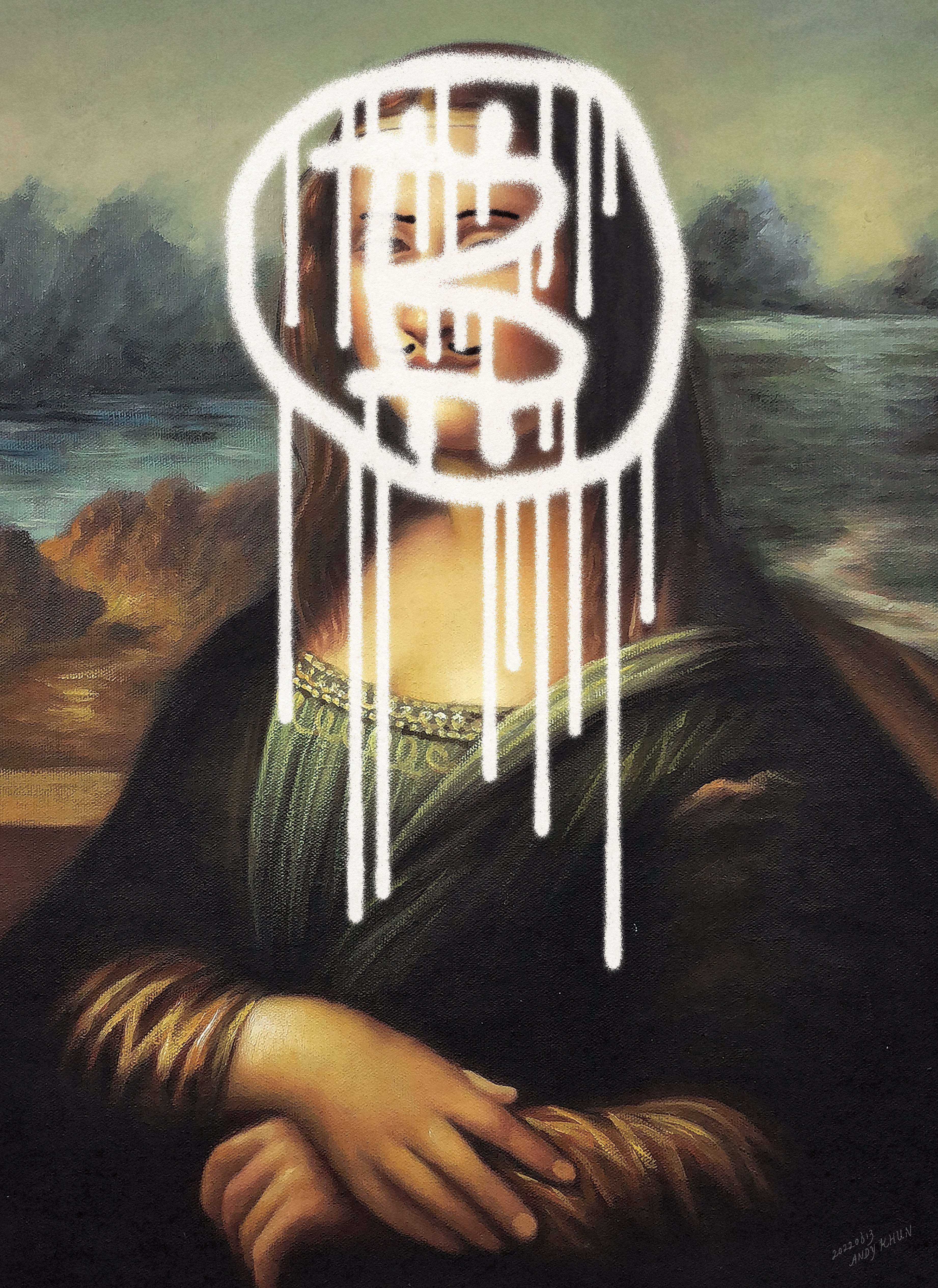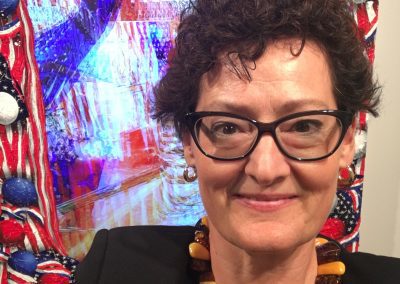
Above: “Discover Your Hidden Talent!” by @saito
The evolving art of appraising NFTs
Even if a work of art is made from gold or diamonds, it has no intrinsic value. What makes artwork valuable is the collective intentionality of human beings. Five hundred years ago, a distractible genius painted a portrait of an unknown woman in muted dark colors that we now call a masterpiece. The “Mona Lisa” hangs behind bulletproof glass and holds the world record for the highest-insured work of art. Painted on a panel of poplar wood only 30 by 21 inches in size, the “Mona Lisa” is valued at close to a billion dollars because of a collaborative belief in its worth and importance.
But while the value of the “Mona Lisa” was determined and has accrued over hundreds of years, contemporary art, specifically NFTs, are experiencing a much steeper, abbreviated, but still complex journey towards value.
When Kevin McCoy minted the first-known NFT, a pixelated octagon titled “Quantum” on the Namecoin blockchain, in 2014, the concepts of scarcity and value were instantly attached to a new art asset. Enter the world of art appraisers (like me), insurance companies, and tech businesses, all striving to comprehend how to sell, buy, trade, donate, and insure NFTs. Because I’ve spent years appreciating traditional art from the subjective viewpoint of a writer and historian and have only recently begun to work as an appraiser, I set out to parse the more objective components required to assign worth to this novel art form.
“Do the same basic characteristics that are used to value traditional art apply to NFTs?” I asked Dr. Martin Pracher, a German art and antique appraiser developing a technique and methodology for NFT valuations.
“They can’t be transferred one-to-one,” he said. “For traditional art, we pose questions to the artworks, such as artist, date, style, scale, provenance, rarity, condition, and utility. For NFTs, we modify these factors.”
He explained that while the artist, date, and style maintain the same significance, a metric such as condition is modified to embrace the new lexicon of cyber instruments. On a canvas, condition can refer to chipped or fading pigment, whereas with an NFT it signifies the stability and security of the off-chain storage. Dimension becomes resolution, i.e., the quality and size of the file format. In physical art, utility denotes a decorative and esthetic benefit. For an NFT, it can also convey game rewards or access to unique content. But while some traits are adjusted, others lose significance. Because provenance is recorded on the blockchain, sales history is transparent. And although an artist’s attribution is sometimes hidden behind an anonymous moniker name like, Pak, obscuring identity is not new in the art world—think of Banksy.
On the other hand, social currency has become paramount. “Social visibility and attention on a [social] network are vitally important in the NFT space.” Pracher explained. Because many NFT artists are working outside the gallery system, they must act very quickly and draw the crowd to their work.
Pracher does more than work as an appraiser. Along with his wife, he is an NFT collector. He considers the significant, often proximate relationship between artists and their collectors when doing a valuation. “The collector is now a value-determining factor,” he told me. Patronage on this scale hasn’t happened since the Renaissance when wealthy merchants began to commission art. Although the current patronage looks very different than it did in the 1500s, in both cases, it’s a factor shaping creative culture. On Pracher’s checklist, he asks: Who is the collector? Why did they collect this artwork? How active were they in the artistic process? Did they purchase to develop a friend, to show their support for a specific project, or contribute to the art’s direction or style?
The collector is now a value-determining factor.
— Dr. Martin Pracher
One of DeeKay’s best 1/1s, now in the hands of the great collector @Artifaction2. Love to see it! 🍷⚔️ https://t.co/VBFGMZJMbW
— Cozomo de’ Medici (@CozomoMedici) August 4, 2022
My final question for Pracher was the one I keep hearing in the appraising world. Since NFTs are primarily traded through cryptocurrency, how do you address the volatility? It turns out that while there is a correlation between the crypto and the NFT markets, they don’t always move in sync. The crossover is not a one-to-one relationship. As an appraiser, Pracher’s approach is practical. “I pick a moment in time. I don’t make future predictions on how works will develop. My question is always, what was the value at a certain point in time.” As a collector, he follows the same practice for NFT-focused art as traditional art. He buys what he loves and thinks of it as a long-term investment.
But the question of fluctuating currency is critical. It’s one of the main reasons insurance companies are reluctant to cover replacement costs and guarantees against the asset. When I reached out to Claudia Hess, a modern, contemporary, and new media art appraiser in San Francisco currently writing a book, “The NFT Handbook for Art Lovers,” she said that several artists she knows are working to solve this problem by minting NFTs in secure wallets with insurance attached. “Sort of like an all-in-one happy meal,” she laughed.
Chris Trueman is a digital artist working on this initiative with several collectors and the gallery Winston Watcher in Seattle. “Many artists and collectors don’t know how to secure assets, and galleries want to be able to tell their collectors their assets are safe from malicious behavior and theft. As an artist myself, I saw an opportunity between the intersection of these three entities,” Trueman said when I reached out to him. “I know deep crypto users believe that if you aren’t storing your own assets, they aren’t yours, but there has to be a compromise while the mainstream adapts to this new product.”
Many artists and collectors don’t know how to secure assets, and galleries want to be able to tell their collectors their assets are safe from malicious behavior and theft.
— Chris Trueman
Chris Trueman
Digital artist working on safeguarding digital assets with several collectors and the gallery Winston Watcher in Seattle.
Claudia Hess
A modern, contemporary, and new media art appraiser and author of the upcoming book, “The NFT Handbook for Art Lovers.”
I love this idea of the NFT art community finding opportunity in a problem. Like the original issue of digital ownership and the GreenNFT movement, this community develops and innovates solutions themselves.
Hess sees this sense of community—the widening and inclusive social sphere of the NFT ecosystem—as the unique, fundamental value of NFTs. “NFTs have allowed more artists of all ages and ethnicities to access the market,” she said. “That’s their true utility token. And maybe that’s what collectors want to support. Inclusivity has not always been present in the art world of the past.”
Both Pracher and Hess are the first to admit that their approaches are slow and methodical, suitable for understanding one-of-one artwork with unique characteristics. Given the volume of digital art emerging, particularly when you consider niches like generative art, sites that harness machine learning might just be the key.
Initially, Upshot aggregated crowdsourced “human” appraisals by posing a series of questions to users and scoring the answers. The problem with this approach was that it wasn’t scalable to the volume of NFTs that flooded the market. Upshot Analytics then pivoted to a machine learning model. Artificial appraisers are now the core of their infrastructure, delivering close to real-time NFT price feeds. Since each NFT collection has its own nuanced model of meta characteristics and tags appreciated by the community, Upshot believes that applications available via specialized algorithms are better equipped to combine patterns and historical data with nearly instantaneous sales. Their analytics track and reprice the top 5,000 NFTs across the marketplace every hour. According to Christopher Kingsley, Upshot’s chief marketing officer, “The site is only open to limited use by 10,000 private Beta users. We’re keeping it small while we figure out what’s useful and accurate.” Yet already, it is possible to view information like floors, average price, and volume for collections.
On the homepage, a chart allowed me to select and compare up to five collections, then zero in on the activity within a collection. Within seconds, I discovered that a trait like burgundy lips on a blue-green background World of Women NFT is more popular than those figures with the same-colored background but with yellow lips—or at least they were the last time I checked. If an NFT is over- or underpriced, an indicator appears at the top of the page, giving the percentage above or below the appraised price. A click then linked me to OpenSea, where I could complete a purchase.
It’s easy to see the power behind a tool like Upshot. It propels adaptation by making it almost seamless for participation. Once it is available, collectors, dealers, auction houses, donors, and appraisers can harness it as an instrument not just for purchase or sale but also for assessment. But while Upshot can map trends, giving the bird’s eye view that a platform like Zillow does for real estate, Kingsley acknowledges it is not yet nuanced enough to predict one-on-one performance valuations for the unique, pop-surrealist blend of a rare Fewocious on sites like SuperRare. “That’s next level,” he said.
Which brings me back to Mona Lisa. While her popularity (social status) took centuries to be fully appreciated, her portrait probably wouldn’t have been considered desirable by machine learning and maybe not even by the humans who viewed it at the time. Da Vinci certainly wasn’t satisfied because he worked on the panel for four years, and it was still in his studio when he died in 1517. Indeed, the Mona Lisa broke from the contemporary tradition of other Renaissance portraits. On a graph or chart of prevalent features and common traits, she’d be the yellow-lipped outlier. Instead of looking down or to the side, the Mona Lisa looks directly at the viewer, an unconventional attribute of portraits of that time. Nor is her form outlined, as was the practice. The Mona Lisa is rendered naturally. Da Vinci employed an innovative technique called sfumato, softening Mona’s features so that she appears realistic. And then there is her extraordinary smile, a mystery no machine, let alone one person, has been able to quite qualify, let alone quantify.
Just like the art of any period, NFT investors may also be blinded by conventional opinions. Value is a response to collective appreciation. Though it lags behind innovation, it also accelerates adaptation. I doubt an NFT will break the Mona Lisa’s record to become the highest insured work of art, but its value will undoubtedly change and evolve as the market expands. In the meantime, we will just have to wait and appraise.

Gabrielle Selz is the award-winning author of Light on Fire: The Art and Life of Sam Francis. She has contributed to The New Yorker, The New York Times, the Los Angeles Times, More Magazine, and The Rumpus, among other publications. Her fiction has appeared in Fiction Magazine and her art criticism in Art Papers, Hyperallergic, Art & Object, and Newsday. She is a recipient of the New York Foundation for the Arts Fellowship in Nonfiction and is a Moth Story Slam Winner.
Art

Curated Conversations: ALIENQUEEN
SuperRare Labs Senior Curator An interviews ALIENQUEEN about psychedelics, death, and her journey in the NFT space.
Tech


Out of the Vault and onto the Chain: the Evolving Nature of Provenance
SuperRare editor Oli Scialdone considers the social experience of provenance and its relationship with community in the Web3 space.
Curators' Choice



Curated Conversations: ALIENQUEEN
SuperRare Labs Senior Curator An interviews ALIENQUEEN about psychedelics, death, and her journey in the NFT space.






